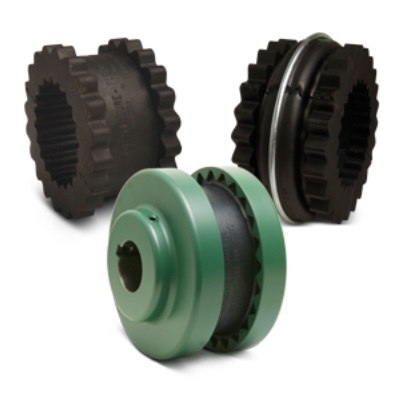Edited by Mike Santora
*Below is an excerpt from the first part of a Design World webinar presentation by John Smihal of TB Wood’s Inc. Here, Smihal covers some best practices for handling sleeve coupling installation.
When we talk about sleeve couplings, we’re talking about the rubber couplings commonly known as the sure-flex in the industry. I think the common theme when talking coupling installation is that there is no one coupling that’s perfect for all applications. Certain types of couplings are more tolerant of misalignment than others. Where you’re going to find sleeve couplings most often is going to be on your basic pump application. Pumps, compressors, fans, blowers. Typically in what I’ll call the medium horsepower range. Probably the sweet spot is say five to a hundred horsepower. Relatively low speeds, typically seventeen-fifty, thirty-six hundred RPM. In that range. It’s typically going to be used where you need a lower-cost coupling that is very forgiving and very tolerant of slight alignment errors on installation.
Typically when people talk misalignment, they’re referring to two different types of misalignment. Angular misalignment and parallel offset misalignment. Generally you have a combination of both, in both the vertical and horizontal planes. Alignment is critical, both for the life of the connective equipment and for the life of the coupling. With every type of coupling, the more misalignment you have, the more reaction loads are going to have on the bearings and the connective equipment, which is going to tend to shorten the life of your bearings, shorten the life of your seals. Although proper alignment is going to make the coupling last longer, you’re really doing it to make the equipment itself last longer because that’s the expensive part of the system.
Additionally, you want to make sure that, when you’re designing your system, that the mounting of the connective equipment is as rigid as possible. If you have flexible machine bases, you’re going to find that although your alignment may be perfect and you can laser-align or dial-indicate or use any kind of precision method to align, as soon as you turn that equipment on and it’s subjected to torque, you’re going to find that if your equipment is not rigidly mounted, you’re going to induce a lot of misalignment into the system. In some cases, depending on the type of coupling you’re using, that can exceed the coupling alignment limits. As everybody else said and I’ll reiterate, when you’re doing your initial installation you want to get the alignments as close to perfect as possible, because the coupling’s job is to allow for the inevitable misalignment that occurs during operation.
TB Wood’s
www.tbwoods.com
